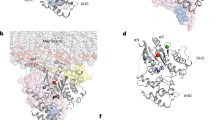Abstract
Guanine-nucleotide binding proteins (G proteins) act as molecular switches in signaling pathways, by coupling the activation of G protein-coupled receptors (GPCRs) at the cell surface to intracellular responses. In the resting state, G protein forms a heterotrimer, consisting of GDP-bound form of the G protein α subunit (Gα(GDP)) and G protein βγ subunit (Gβγ). Ligand binding to GPCRs promotes the GDP-GTP exchange on Gα, leading to the dissociation of the GTP-bound form of Gα (Gα(GTP)) and Gβγ. Then, Gα(GTP) and Gβγ bind to their downstream effector enzymes or ion channels and regulate their activities, leading to a variety of cellular responses. Finally, Gα hydrolyzes the bound GTP to GDP and returns to the resting state by re-associating with Gβγ. G proteins are classified with four major families based on the amino acid sequences of Gα: i/o, s, q/11, and 12/13. Each family transduces the signaling from different GPCRs to the specific effectors. Here, we established the backbone resonance assignments of human Gαi3, a member of the i/o family, with a molecular weight of 41 K in complex with a GTP analogue, GTPγS.

Similar content being viewed by others
References
Abdulaev NG, Mao X, Ramon E, Ngo T, Mysliwy J, Marino JP, Ridge KD (2005) Bacterial expression and one-step purification of an isotope-labeled heterotrimeric G-protein α-subunit. J Biomol NMR 32:31–40
Edison AS, Abildgaard F, Westler WM, Mooberry ES, Markley JL (1994) Practical introduction to theory and implementation of multinuclear, multidimensional nuclear magnetic resonance experiments. Methods Enzymol 239:3–79
Gilman AG (1987) G proteins: transducers of receptor-generated signals. Ann Rev Biochem 56:615–649
Mal TK, Masutomi Y, Zheng L, Nakata Y, Ohta H, Nakatani Y, Kokubo T, Ikura M (2004) Structural and functional characterization on the interaction of yeast TFIID subunit TAF1 with TATA-binding protein. J Mol Biol 339:681–693
Oldham WM, Hamm HE (2006) Structural basis of function in heterotrimeric G proteins. Q Rev Biophys 39:117–166
Rovnyak D, Frueh DP, Sastry M, Sun ZJ, Stern AS, Hoch JC, Wagner G (2004) Accelerated acquisition of high resolution triple-resonance spectra using non-uniform sampling and maximum entropy reconstruction. J Mag Res 170:15–21
Salzmann M, Pervushin K, Wider G, Senn H, Wuthrich K (1998) TROSY in triple-resonance experiments: new perspectives for sequential NMR assignment of large proteins. Proc Natl Acad Sci USA 95:13585–13590
Salzmann M, Wider G, Pervushin K, Senn H, Wuthrich K (1999) TROSY-type triple-resonance experiments for sequential NMR assignments of large proteins. J Am Chem Soc 121:844–848
Simon MI, Strathmann MP, Gautam N (1991) Diversity of G proteins in signal transduction. Science 252:802–808
Sprang SR, Chen Z, Du X (2007) Structural basis of effector regulation and signal termination in heterotrimeric Gα proteins. Adv Protein Chem 74:1–65
Acknowledgments
This work was supported in part by grants from the Japan New Energy and Industrial Technology Development Organization (NEDO) and the Ministry of Economy, Trade, and Industry (METI) (to I. S.), a grant-in-aid for Scientific Research on Priority Areas from the Japanese Ministry of Education, Culture, Sports, and Technology (MEXT) (to M. O. and I. S.), Global COE Program “Medical System Innovation on Multidisciplinary Integration” from MEXT (to Y. M.), and a grant from Takeda Science Foundation (to M. O.). Y. M. is a research fellow of the Japan Society of Promotion of Science (JSPS).
Author information
Authors and Affiliations
Corresponding author
Rights and permissions
About this article
Cite this article
Mase, Y., Yokogawa, M., Osawa, M. et al. Backbone resonance assignments for G protein αi3 subunit in the GTP-bound state. Biomol NMR Assign 6, 217–220 (2012). https://doi.org/10.1007/s12104-012-9361-6
Received:
Accepted:
Published:
Issue Date:
DOI: https://doi.org/10.1007/s12104-012-9361-6




